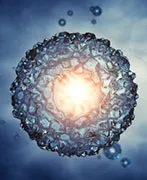Measuring mitochondria in cells better predicted success rate with in vitro fertilization, study says
WebMD News from HealthDay

By Dennis Thompson
HealthDay Reporter
MONDAY, Oct. 14 (HealthDay News) -- Doctors have unveiled a new test for determining which embryos have the best chance of survival.
The amount of mitochondria found in the cells of an embryo appeared to be a marker of its health, doctors reported Monday at the International Federation of Fertility Societies and American Society for Reproductive Medicine annual meeting in Boston. Research presented at meetings is considered preliminary until published in a peer-reviewed medical journal.
Higher levels of mitochondria -- the "powerhouses" of cells -- seemed to indicate an embryo was under stress and less likely to successfully implant in a woman's uterus, said study co-author Dr. Dagan Wells, a scientific leadership fellow at Oxford University in England.
The researchers were able to establish a mitochondrial threshold above which they felt sure an embryo wouldn't be able to implant in a uterus, he said.
By selecting the healthiest embryos, doctors hope to cut down on unsuccessful implantations and miscarriages.
Doctors already can screen embryonic cells to make sure they have the proper number of chromosomes. Previous research has found that if embryos have more or fewer than the usual 46 chromosomes -- 23 from the mother and 23 from the father -- they rarely survive implantation, Wells said.
When doctors add the mitochondria test to the chromosome count, they will be able to increase the rate of successful embryo implantation from between 60 percent and 65 percent to as high as 80 percent, he said.
"We think this will get us to a significantly improved birth rate, and we are planning clinical trials," Wells said.
Dr. Joe Leigh Simpson, president of the International Federation of Fertility Societies, hailed the new findings as creating a "better mouse trap" for screening embryos.
"We can simply add mitochondrial assessment at the same time as chromosomal screening, and better address the disappointment of why we don't get a success," Simpson said. "I would look upon this as providing transformative information. There would be fewer cycles required to produce a baby that one could take home."
In the 30 years since the discovery of in vitro fertilization, more than 5 million babies have been born worldwide due to the technique. "In any classroom, there's likely to be one or two IVF children among them," Wells said.
But the process is still relatively inefficient. "Only about 30 percent of IVF cycles actually produce a baby," Wells said. "Many patients have to undergo multiple IVF cycles before they finally achieve that much-desired baby."
Researchers decided to look at mitochondria as a possible culprit for unsuccessful implantation. Mitochondria are responsible for creating usable forms of energy for a cell. They also are involved in key cellular processes such as cell signaling, cell differentiation and programmed cell death.
source : New Test May Spot Which Embryos Stand Greatest Chance of Survival








